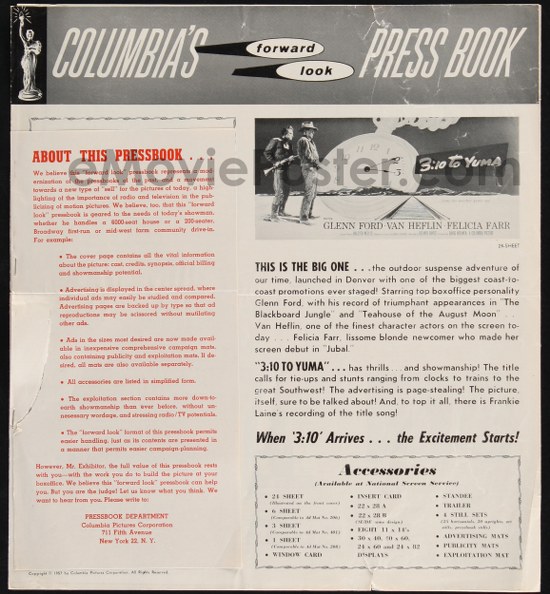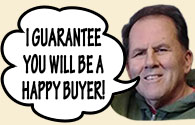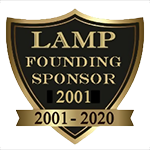|
|
eMoviePoster.com - The most trusted vintage original movie poster site & the only major online auction with no buyers premiums!
Did you know... that pressbooks once were very elaborate, but over the years, they got smaller and showed fewer posters?
Return to Did You Know ArchiveAdded: 10/20/2014
First, here is a brief overview and history of pressbooks (we put this on every auction of a
pressbook):
What are Pressbooks?
Pressbooks were special advertising booklets sent directly to theater
owners that were playing the specific movie advertised in a particular pressbook (almost all
pressbooks were for one movie only, although there were some double-bill pressbooks). A pressbook
was made for every movie, starting in the mid 1910s through the 1970s (somewhere in the late
1960s, studios introduced "presskits", which included brochures and stills from the movie, but
NO
images of the posters, and for a few years, they made both, but then they stopped making pressbooks
and only made presskits).
Each pressbook (especially the early ones) is filled with lots of information about the movie that is
contained no where else, including pictures of many of the posters and articles and ads as well, and
the cover of the pressbook is often a color poster that could be framed, and on older pressbooks
there is often a "sample" full-color herald attached to the pressbook, and yet, because many
collectors don't know about pressbooks, the entire pressbook often sells for less than the price of
a single lobby card from the same movie!
Pressbooks were sent to movie theater owners to help them promote the film.
They have lots of "newspaper" black and white ads in various sizes for theaters to use in their local newspaper
(theater owners would literally cut out the ad they wanted to use and give it to their local paper,
which is precisely why so many pressbooks have ads cut out of them). For collectors, the most
important thing about pressbooks is that they
show many of the posters that were created for the film (one-sheet, three-sheet, etc.).
Sometimes
not a single copy of a poster is known to exist and the only way you can tell what the poster looked
like is by looking at a picture of it in the pressbook. In addition to poster images and newspaper
ads, most pressbooks also have a synopsis of the film and
other information like stories about several of the stars and sometimes a story about the making of
the film, profiles of the lead actors, etc. Many pressbooks include unusual ways to promote the film such as having a nurse at the
theater in case anyone fainted, vomit bags for queasy patrons, etc. They often contain info on other
promotional items like photos, radio spots and standees that were available to the theater owner,
most of which are not currently known.
In format, pressbooks are very similar to comic books. They
often have two-color or full-color covers, but almost always have black & white interiors.
Generally, the most important the film, and the older the film, the more elaborate the pressbook
(larger size and greater number of pages).
Note that pressbooks often contain single sided pages.
When we are auctioning a pressbook, we list the number of pages in a pressbook, and that number refers to the number of
SIDES of pages
that have printing. If a pressbook has 10 pages with printing on one side each, we say it has 10
pages; if it has 10 pages with printing on both sides each, we say it has 20 pages.
Pressbooks are
almost always extremely difficult to find from pre-1960 films and are rapidly becoming more and more desirable, as
more collectors learn of them! Often pressbooks sell for the same or less than a scene lobby card
from the same film, yet they give so much more and are much more difficult to find!
Now, back to the topic at hand, the transition from deluxe
pressbooks to much smaller versions. The earliest pressbooks I have seen are from the middle 1910s,
and they are pretty simple. They are almost always all black and white, measure around 8 1/2 by 11,
and often the pages are simply stapled together. There is usually just one page with images, showing
either just the one-sheet, or the one-sheet and three-sheet.
By the early 1920s, pressbooks had grown a lot in size, but they
were still mostly all black and white, and often printed on pulp paper like newspapers. But
somewhere in the mid to late 1920s, the studios started adding color covers, and often put the
posters on the back in full-color, and the bigger the movie, the more elaborate the pressbook!
They continued making these really elaborate pressbooks until the early 1940s, when World War II
hurt the studios' bottom lines, and pressbooks started losing color and page count. By the early
1950s only really major movies (for the most part) received elaborate pressbooks, and the larger,
more successful studios made nicer ones, and the smaller studios made more and more simple ones.
By 1957, lots of studios were really hurting, as TV had drastically
cut into the movie audience for all but the most successful movies. Columbia Studios that year
decided to save a bunch of money by cutting down the page count of their pressbooks to mostly four
or six pages, and they attached the below announcement (click on it for a more readable version) to
the front of each pressbook, to announce this cutback (but of course, to save face, they tried to
make it look like they were trying to save the theater owners' time, by "streamlining" the
pressbook!
But did you know WHEN it was that pressbook transitioned
from a deluxe large "magazine" like items to a four, six, or eight page "brochure" like item? It did
not happen all at once, but there WAS a key transition time.


Of course, it was just a matter of time before all the other studios followed suit on all but the
best movies. And around this time they introduced "presskits", which included brochures and stills
from the movie, but NO
images of the posters, and for a few years, they made both, but then they stopped making pressbooks
and only made presskits).
But the Golden Age of pressbooks was from around 1925 to around 1945, and most of those from 1946 to
1956 are of a lesser quality, and most of those from after 1956 are of a MUCH lesser quality.

|
Complete Buyer Protection - No time limit on our guarantees & NO buyer beware
Hershenson
Help Hotline - Direct line to Bruce (our owner!) for urgent problems
Also, please read the following two pages of Consignor Reviews
-
Page 1,
Page 2,
and two pages of Customer Reviews of our company
-
Page 1,
Page 2,
which shows you in our customers' own words exactly what makes our company and our auctions so very different from all others! |
 |

Postal Mailing Address: Bruce Hershenson, P.O. Box 874, West Plains, MO 65775.
(For our UPS or FedEx address, click here)
Our address for UPS or FedEx only is:
Bruce Hershenson,
306 Washington Avenue, West Plains, MO 65775
phone: +1 417 256-9616 fax: +1 417 257-6948
E-mail: Contact Us
Hours of Operation:
Monday - Friday 8:30 AM - 12:00 PM & 1:00 PM - 5:00 PM (CST)
|
|








